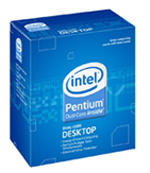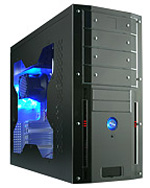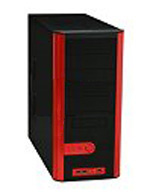System Buyers Guide: PCs for Under $1000
by Wesley Fink on December 29, 2008 3:00 AM EST- Posted in
- Guides
Intel Entry-level PC
While Intel still owns the top of the CPU performance charts, the area from midrange to entry is very competitive between Intel and AMD. The one advantage that remains for Intel is that their processors generally overclock much better than current AMD CPUs. This is not normally a consideration in entry computers, but it could be for some buyers.
| Intel Entry-level PC | ||
| Hardware | Component | Price |
| Processor | Intel Pentium Dual-Core E5200 Wolfdale (Dual-core 2.5GHz 65W 2MB Shared L2 800FSB) |
$83 |
| Cooling | CPU Retail HSF | - |
| Video | Onboard | - |
| Motherboard | Zotac N73PV-Supreme NVIDIA GeForce 7100 HDMI | $60 |
| Memory | Kingston 4GB DDR2-800 Kit (KVR800D2N5K2/4G) | $37 |
| Hard Drive | WD Caviar GP WD5000AACS 500GB | $59 |
| Optical Drive | Samsung 22X DVDRW/DL SH-S202G | $25 |
| Audio | Onboard | - |
| Case | Rosewill TU-155 with 400W | $60 |
| Power Supply | Included with Case | - |
| Display | Hanns-G HB-175APB 17" 8ms Widescreen LCD Monitor Built in Speakers - Retail (1440x900) | $99 |
| Speakers | Built-in Monitor | - |
| Input | Microsoft CA9-00001 PS/2 Standard Keyboard and Optical USB/PS2 Mouse - OEM | $16 |
| Operating System | Microsoft Vista Home Premium OEM | $99 |
| Bottom Line | $538 | |
 |
Our choice for the Intel entry CPU is the excellent 2.5GHz dual-core E5200 Wolfdale. This 65W CPU uses 800FSB, so right out of the box the first option for overclock, if you are so inclined, is to bump the FSB up to 1066. Even if you never overclock you will be very pleased with the performance of the E5200. We do not recommend going lower than an E5200 in an Intel system because the tradeoffs in performance for the few dollars saved are too great. The E1200 at $53, for example, is dismal compared to the E5200, and certainly not a good choice in performance for the $30 saved.
 |
In the past year, some motherboards for Intel systems have finally reached price parity with AMD systems. One example is the Zotac board chosen for the entry Intel system. The ZOTAC N73PV-Supreme is based on the GeForce 7100. This uATX motherboard features HDMI output, Gigabit LAN, four 3Gb/s SATA ports, 10 USB ports, HD audio, one PCI-E x16 slot, one PCI-E x1 slot, two PCI slots, and support for 4GB RAM. This board offers excellent stability and performance for the money. Pair it up with an E5200 and 4GB of DDR2-800 and you have a solid SOHO system
 |
The rest of the components are virtually identical to the AMD entry-level system. This includes the Rosewill TU-155 case with 400W PSU from Newegg. It is a versatile case that will house any entry to midrange system at a current cost of $60. The TU-155 with PSU often goes on sale for $50 so it pays to shop if it is important to save every dollar possible. We generally do not recommend cases that come with a power supply, but our long-term experience with this 400W PSU has been positive with no problems - though certainly efficiency isn't going to compete with PSUs that cost as much on their own as this case/PSU combo. If you're interested in getting a better quality, higher efficiency 300-450W PSU, we'll have a couple massive roundups in the near future, so check back later this week.
 |
A good case alternative is the well-known Cooler Master Centurion 5 Red FR-T05-URI-GP with 430W power supply for the same $60. This black case with red trim stands out in both appearance and in its flexible interior that can handle five 5.25" devices, two 3.5" devices, and three internal hard drives. There is also an installed 120mm exhaust fan on the rear in the CPU area.
If we compare the two entry-level systems, the winner depends on what you value most. The Intel system is a bit more powerful, but you can move up to a high-end Athlon 64 X2 or a low-end AMD Phenom X3 for comparable performance at less than $100. The full-size AMD ASRock board offers more flexibility for future graphics expansion, with two x16 PCIe slots and Crossfire X support. If you are a gamer on a strict budget, the AMD entry system offers you more options for future graphics expansion. For the typical entry-level PC right now, and for what the system is typically used for - internet, office, low-end gaming, and low to mid graphics - you can go either route and be happy.










38 Comments
View All Comments
Wixman666 - Monday, December 29, 2008 - link
Nonsense, you're forgetting that they are posting builds that are user friendly for the general public. 99% of the people in the US couldn't install Linux if their life depended on it. Even for many supposed "power users" it is not exactly friendly.While it is indeed a good alternative, Linux is still just not for the mainstream.
You guys also neglected to choose Vista 64 for forward thinking. Buying a 32 bit OS today is like throwing away money. If I wanted a 32 bit OS I'd buy XP home, pro, or media center.
n0nsense - Tuesday, December 30, 2008 - link
People in US do install and use Linux like in any other place.Dumb
Anyway you will install some OS and installing Vista is at least longer process at the first time and "find the drivers CD" on next time since even NIC wont work out of the box in most cases (XP much worse with default drivers).
And usability, if my 60 years old (in average) parents can use it without calling me few times a week (like they did with XP), anyone can :)
strikeback03 - Monday, December 29, 2008 - link
I'd guess that most users considering assembling their own computers (and for that matter most users who can put a CD in the drive) could install Ubuntu. And with reasonably mainstream hardware they might even have it run flawlessly. If you are willing to use the forums and such to find help you probably can get it to run on just about any system. The problem is that lots of people want it to just work, and you never know what you are getting with each new release. I have been using Ubuntu since 6.10 on my desktop and 7.04 on my laptop. Each release I have installed on the desktop has required new kernel flags to work around problems (noapic, nolapic, all_generic_ide, etc), and the 7.04, 7.10, and 8.04 LiveCDs didn't even boot without help. With 8.10 they seem to have fixed all that, I still haven't gotten around to actually installing it but it runs perfectly off a flash drive. My laptop (Thinkpad T43) , OTOH, had zero problems with any of the releases prior to 8.10, everything did just work. So I went ahead and installed 8.10 without any trial period, and it broke Wireless support, so that it would constantly disconnect from the router, then most times ask for the password on reconnecting and sometimes refusing to reconnect at all. Obviously not acceptable, so I went back to 8.04.I have installed Ubuntu on several other systems at work without problems (including one which is almost identical to my troubled desktop), but the point is that a lot of users probably don't want the uncertainty of whether their hardware will be happy with the software or not. Not that Vista has a spotless hardware support history, but most users probably feel more comfortable finding support for that than Linux.
JarredWalton - Monday, December 29, 2008 - link
Actually, we didn't specifically state whether you should buy the 64-bit or 32-bit version, though we did mention that 64-bit is the way to go if you run 4GB or more RAM. There's only a couple applications I use regularly that utterly fail under 64-bit Vista: Dragon NaturallySpeaking (still waiting for their 64-bit update!) and Gametap (a bunch of the games fail to install/work under 64-bit Vista). So it's still not 100% the same as 32-bit, but I do run 64-bit for my primary gaming PC. My work PC remains 32-bit until the Dragon issue is fixed.sprockkets - Monday, December 29, 2008 - link
If you can assemble a computer, you can install Linux.By the way, that WD Green drive has NEVER been a variable speed drive; it operates at 5400rpm ALL the time. WD just doesn't want the public to fret over the fact that it is a 5400rpm drive so they obfuscate this fact as much as possible.
cbutters - Monday, December 29, 2008 - link
I was just about to post that the WD wasn't a variable speed drive, but I see you have commented on it already, therefore, I second your post.n0nsense - Monday, December 29, 2008 - link
Truly, I can't understand why 20% of computer cost should be spent on OS.Yes, you can argue that other OS does not really support ALL games.
But when talking about Internet/Office/Media non professional use (in professional people can choose Mac) for what f... reason should person to spend this 100 USD on something really not needed. Actually it's more then 100$ since they gonna need "good anti everything" soft which will slow down their already not so fast computers.
On the other hand they can opt for something like Mythbuntu for HTPC, or Ubuntu for normal desktop and spend saved money on something better like tripling disk space, getting decent dedicated graphics and other things.
And i'm disappointed that you don't even mention this.
and please, add preview button for posts :)
DerwenArtos12 - Monday, December 29, 2008 - link
Why didn't you all use the Corsair ram you were raving about in your memory guide, it's only a couple bucks more?Wesley Fink - Tuesday, December 30, 2008 - link
We certainly like the Corsair memory as well. As we said in the Buyers Guide:"RAM prices as a whole are certainly in the commodity category as of late. We recommended the Kingston 4GB DDR2-800 kit, but you could just as easily choose OCZ, G.Skill, Corsair, Crucial, GeIL, Patriot, or any other quality DDR2-800 name and shop for the memory based on a combination of price and the company's support reputation."
BernardP - Monday, December 29, 2008 - link
I have had a system based on Asus M3N78-VM GeForce 8200 motheboard for a month. I have all the latest chipset, audio (NVidia + VIA) and video drivers installed. I have tried all possible audio settings and configurations, in WinXP and BIOS. Despite this, I have been unable to get audio through HDMI, although the HDMI video is perfect @ 1280x720.Searching on the net, this seems to be a widespread problem. Some users report they have HDMI audio working, but they don't seem to have done anything special to make it work.
The fundamental problem is that, on my system, there is no visible option to select HDMI audio, either in Hardware Manager or Control Panel/Sounds.
Anyone knows the sure-fire recipe to enable audio through HDMI on the 8200/8300 chipset?